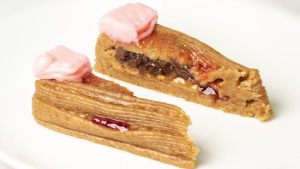A Taste of the Future: 3D Printed Food
By Asha Egmont, C2ST Intern, Loyola University
Imagine a customizable meal at the touch of a button! It sounds like something out of The Jetsons, but it is quickly becoming a reality. Scientists are working to develop a reliable technology for the 3D printing of edible and nutritious food items.

A photo of a 3D printed Cherry Cheesecake printed by researchers at Columbia University in March 2023 (4).
The technology that creates 3D printed food is in the works to be a hugely beneficial tool. As it improves, it will be able to produce and create foods that have specific nutrient densities (1). These foods could cater to the dietary needs of different groups of people, such as those with medical issues like diabetes or high cholesterol, those whose line of work is especially physically exerting, or those who are looking for vegan and vegetarian meat substitutes. This method of producing food allows for complete control over the concentrations of nutrients like fats and proteins, as well as additives like caffeine and a variety of vitamins.
3D printing is most often seen as a means of printing inedible 3D objects using a tool that melts and extrudes plastic based on a blueprint designed on a computer program. When 3D printing food, rather than plastic, the materials are typically a mixture of hydrogels, proteins, and starches (2). Hydrogels are edible, water retaining substances produced with gelatinizing agents, like carrageenan (red seaweed), and they are often what hold 3D printed food in a specific shape. These materials can be combined to create the correct textures for different foods. Further, they can be flavored and shaped to create a familiar taste and texture experience for consumers. With additives, the nutritional values can be adjusted to mimic the actual food.
However, the technology is not quite ready to serve up 3D printed food using fruits and vegetables because these food products tend to have a texture that is not suitable for holding shapes. Without being able to utilize fruits and vegetables, consumers will not be able to obtain nutritional benefits equivalent to the real thing (2). But that doesn’t mean you can’t have your cake and eat it too!
Recently, researchers at Columbia University were able to 3D print a cherry cheesecake using food ink made from ingredients like Nutella, strawberry jam, graham cracker crust, peanut butter, and frosting (3). It may not look very appealing, but the achievement of being able to print a cake that was fully edible and had controlled amounts of nutrients is rather incredible
Without people to eat this printed food, the tool would be virtually useless. But how do consumers really feel about 3D printed snacks? Many of them assume that this food would be inedible, taste bad, pose health risks, or be nutritionally lacking (4). In a lot of ways, this reaction is justified. The technology is unfamiliar, and most often associated with non-food items. It makes sense to be skeptical of food that is not sourced from nature, or at least natural ingredients. People’s acceptance of these novel food technologies is also dependent on other factors like socioeconomic status. If this technology enters the upscale restaurant business before the regular market, those with a higher socioeconomic status will be more likely to participate in it (4). As this technology develops further, and more of a focus is placed on taste and appearance of food, it is likely that it will become more appetizing to an average consumer.
With all of that on your plate, what are your thoughts on 3D printed food? Would you be willing to try a 3D printed cheesecake?
Sources:
- https://cen.acs.org/food/food-science/3D-printed-foods-enter-kitchen/100/i5
- https://ifst.onlinelibrary.wiley.com/doi/pdf/10.1111/ijfs.15391?casa_token=EnRXi0QSo_MAAAAA:I_b0bFy5163njS96BCpjBeXuf_MpQaPg4dnDqWhTjYiCg50pzG5m_GBSGCh-deUBt-QwJZ0PAl_E0kY&saml_referrer
- https://www.engineering.columbia.edu/news/honey-the-3d-print-i-mean-dessert-is-ready
- https://www.sciencedirect.com/science/article/pii/S0950329317303002